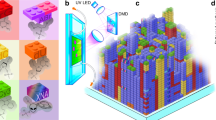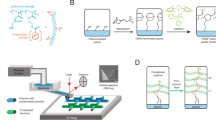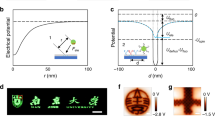Abstract
Molecular printing techniques, which involve the direct transfer of molecules to a substrate with submicrometre resolution, have been extensively developed over the past decade and have enabled many applications. Arrays of features on this scale have been used to direct materials assembly, in nanoelectronics, and as tools for genetic analysis and disease detection. The past decade has witnessed the maturation of molecular printing led by two synergistic technologies: dip-pen nanolithography and soft lithography. Both are characterized by material and substrate flexibility, but dip-pen nanolithography has unlimited pattern design whereas soft lithography has limited pattern flexibility but is low in cost and has high throughput. Advances in DPN tip arrays and inking methods have increased the throughput and enabled applications such as multiplexed arrays. A new approach to molecular printing, polymer-pen lithography, achieves low-cost, high-throughput and pattern flexibility. This Perspective discusses the evolution and future directions of molecular printing.
This is a preview of subscription content, access via your institution
Access options
Subscribe to this journal
Receive 12 print issues and online access
$259.00 per year
only $21.58 per issue
Buy this article
- Purchase on Springer Link
- Instant access to full article PDF
Prices may be subject to local taxes which are calculated during checkout




Similar content being viewed by others
References
Pease, R. F. W. Nanolithography and its prospects as a manufacturing technology. J. Vac. Sci. Technol. B 10, 278–285 (1992).
Rai-Choudhury, P. (ed.) Handbook of Microlithography, Micromachining and Microfabrication Vol. 1 (SPIE Press, 1997).
Chou, S. Y., Krauss, P. R. & Renstrom, P. J. Imprint lithography with 25-nanometer resolution. Science 272, 85–87 (1996).
Wouters, D., Hoeppener, S. & Schubert, U. S. Local probe oxidation of self-assembled monolayers: Templates for the assembly of functional nanostructures. Angew. Chem. Int. Ed. 48, 1732–1739 (2009).
Xia, Y. & Whitesides, G. M. Soft lithography. Angew. Chem. Int. Ed. 37, 550–575 (1998).
Gates, B. D. et al. New approaches to nanofabrication: Molding, printing, and other techniques. Chem. Rev. 105, 1171–1196 (2005).
Ginger, D. S., Zhang, H. & Mirkin, C. A. The evolution of dip-pen nanolithography. Angew. Chem. Int. Ed. 43, 30–35 (2004).
Salaita, K., Wang, Y. & Mirkin, C. A. Applications of dip-pen nanolithography. Nature Nanotech. 2, 145–155 (2007).
Huo, F. et al. Polymer pen lithography. Science 321, 1658–1660 (2008).
Binnig, G., Rohrer, G., Gerber, Ch. & Weibel, E. Surface studies by scanning tunneling microscopy. Phys. Rev. Lett. 49, 57–61 (1982).
Binnig, G., Quate, C. F. & Rohrer, Ch. Atomic force microscope. Phys. Rev. Lett. 56, 930–933 (1986).
Mccarty, G. S. & Weiss, P. S. Scanning probe studies of single nanostructures. Chem. Rev. 99, 1983–1990 (1999).
Gimzewski, J. K. & Joachim, C. Nanoscale science of single molecules using local probes. Science 283, 1683–1688 (1999).
Eigler, D. M. & Schweizer, E. K. Positioning single atoms with a scanning tunneling microscope. Nature 344, 524–526 (1990).
Crommie, M. F., Lutz, C. P. & Eigler, D. M. Confinement of electrons to quantum corrals on a metal surface. Science 262, 218–220 (1993).
Cuberes, M. T., Schlittler, R. R. & Gimzewski, J. K. Room-temperature repositioning of individual C60 molecules at Cu steps: Operation of a molecular counting device. Appl. Phys. Lett. 69, 3016–3018 (1996).
Heyde, M. et al. Dynamic plowing nanolithography on polymethylmethacrylate using an atomic force microscope. Rev. Sci. Instrum. 72, 136–141 (1992).
Liu, J.-F., Cruchon-Dupeyrat, S., Garno, J. C., Frommer, J. & Liu, G.-Y. Three-dimensional nanostructure construction via nanografting: Positive and negative pattern transfer. Nano Lett. 2, 937–940 (2002).
Minne, S. C., Manalis, S. R., Atalar, A. & Quate, C. F. Independent parallel lithography using the atomic force microscope. J. Vac. Sci. Tech. B 14, 2456–2461 (1996).
Minne, S. C. et al. Centimeter scale atomic force microscope imaging and lithography. Appl. Phys. Lett. 73, 1742–1744 (1998).
Moaz, R., Cohen, S. R. & Sagiv, J. Nanoelectrochemical patterning of monolayer surfaces: Toward spatially defined self-assembly of nanostructures. Adv. Mater. 11, 55–61 (1999).
Piner, R. D. et al. Dip-pen nanolithography. Science 283, 661–663 (1999).
Jaschke, M. & Butt, H.-J. Deposition of organic material by the tip of a scanning force microscope. Langmuir 11, 1061–1064 (1995).
Ivanisevic, A. et al. Redox-controlled orthogonal assembly of charged nanostructures. J. Am. Chem. Soc. 123, 12424–12425 (2001).
Nyamjav, D. & Ivanisevic, A. Properties of polyelectrolyte templates generated by dip-pen nanolithography and microcontact printing. Chem. Mater. 16, 5216–5219 (2004).
Demers, L. M., Ginger, D. S., Park, S. J., Li, Z., Chung, S. W. & Mirkin, C. A. Direct patterning of modified oligonucleotides on metals and insulators by dip-pen nanolithography. Science 296, 1836–1838 (2002).
Lee, K.-B. et al. Protein nanoarrays generated by dip-pen nanolithography. Science 295, 1702–1705 (2002).
Lee, K. B., Lim, J. H. & Mirkin, C. A. Protein nanostructures formed via direct-write dip-pen nanolithography. J. Am. Chem. Soc. 125, 5588–5589 (2003).
Cho, Y. & Ivanisevic, A. TAT peptide immobilization on gold surfaces: A comparison study with a thiolated peptide and alkylthiols using AFM, XPS and FT-IRRAS. J. Phys. Chem. B 109, 6225–6232 (2005).
Smith, J. C. et al. Nanopatterning the chemospecific immobilization of cowpea mosaic virus capsid. Nano Lett. 3, 883–886 (2003).
Vega, R. A. et al. Nanoarrays of single virus particles. Angew. Chem. Int. Ed. 44, 6013–6015 (2005).
Liu, X. et al. Arras of magnetic nanoparticles patterned via “dip-pen nanolithography”. Adv. Mater. 14, 231–234 (2002).
Gundiah, G. et al. Dip-pen nanolithography with magnetic Fe2O3 nanocrystals. Appl. Phys. Lett. 84, 5341–5343 (2004).
Ding, L., Li, Y., Chu, H. B., Li, X. M. & Liu, J. Creation of cadmium sulfide nanostructures using AFM dip-pen nanolithography. J. Phys. Chem. B 109, 22337–22340 (2005).
Wang, Y. et al. Controlling the shape, orientation, and linkage of carbon nanotube features with nano affinity templates. Proc. Natl Acad. Sci. USA 103, 2026–2031 (2006).
Giam, L. R., Wang, Y. & Mirkin, C. A. Nanoscale molecular transport: The case of dip-pen nanolithography. J. Phys. Chem. A 113, 3779–3782 (2009).
Jang, J. W. et al. Dip-pen nanolithography generated metal photomasks. Small doi:10.1002/smll.200801837 (2009).
Tang, Q. & Shi, S. Q. Preparation of gas sensors via dip-pen nanolithography. Sens. Actuat. B 131, 379–383 (2008).
Lee, K. B. et al. The use of nanoarrays for highly sensitive and selective detection of human immunodeficiency virus type 1 in plasma. Nano Lett. 4, 1869–1872 (2004).
Yapici, M. K. & Zou, J. Dip pen nanolithography functionalized electrical gaps for multiplexed DNA detection. Anal. Chem. 80, 5899–5904 (2008).
Wang, Y. et al. A self-correcting inking strategy for cantilever arrays addressed by an inkjet printer and used for dip-pen nanolithography. Small 4, 1666–1670 (2008).
Kumar, A. & Whitesides, G. M. Features of gold having micrometer to centimeter dimensions can be formed through a combination of stamping with an elastomeric stamp and an alkanethiol “ink” followed by chemical etching. Appl. Phys. Lett. 63, 2002–2004 (1993).
Weibel, D. B. et al. Bacterial printing press that regenerates its ink: Contact-printing bacteria using hydrogel stamps. Langmuir 21, 6436–6342 (2005).
Zheng, Z., Jang, J.-W., Zheng, G. & Mirkin, C. A. Topographically flat, chemically patterned PDMS stamps made by dip-pen nanolithography. Angew. Chem. Int. Ed. 47, 9951–9954 (2008).
Suh, K. Y., Khademhosseini, A., Jon, S. & Langer, R. Direct confinement of individual viruses within polyethylene glycol (PEG) nanowells. Nano Lett. 6, 1196–1201 (2006).
Bettiger, P. et al. The “Millipede”- nanotechnology entering data storage. IEEE Trans. Nanotechnol. 1, 39–55 (2002).
Salaita, K. et al. Sub-100 nm, centimeter scale, parallel dip-pen nanolithography. Small 1, 940–945 (2005).
Salaita, K. et al. Massively parallel dip-pen nanolithography with 55,000 pen two-dimensional arrays. Angew. Chem. Int. Ed. 45, 7220–7223 (2006).
Schulze, A. & Downward, J. Navigating gene expression with microarrays— a technology review. Nature Cell Biol. 3, E190–E195 (2001).
Rodolfa, K. T., Bruckbauer, A., Zhou, D., Korchev, Y. E. & Klenerman, D. Two-component graded deposition of biomolecules with a double-barreled nanopipette. Angew. Chem. Int. Ed. 44, 6854–6859 (2005).
Hong, S. H., Zhu, J. & Mirkin, C. A. Multiple ink nanolithography: Toward a multiple-pen nano-plotter. Science 286, 523–525 (1999).
Hong, S. & Mirkin, C. A. A nanoplotter with both parallel and serial writing capabilities. Science 288, 1808–1811 (2000).
Hong, J. M., Ozkeskin, F. M. & Zou, J. A micromachined elastomeric tip array for contact printing with variable dot size and density. J. Micromech. Microeng. 18, 015003 (2008).
Salaita, K. et al. Spontaneous “phase separation” of patterned binary alkanethiol mixtures. J. Am. Chem. Soc. 127, 11283–11287 (2005).
Liu, X. et al. The controlled evolution of a polymer single crystal. Science 307, 1763–1766 (2005).
Vega, R. A. et al. Monitoring single-cell infectivity from virus-particle nanoarrays fabricated by parallel dip-pen nanolithography. Small 9, 1482–1485 (2007).
Braunschweig, A. B., Senesi, A. J. & Mirkin, C. A. Redox activating dip-pen nanolithography (RA-DPN). J. Am. Chem. Soc. 131, 922–923 (2009).
Su, M., Li, S. & Dravid, V. Miniaturized chemical multiplexed sensor array. J. Am. Chem. Soc. 125, 9930–9931 (2003).
DeVinne, T. L. The Invention of Printing (Francis Hart & Co, 1969).
Acknowledgements
C.A.M. acknowledges AFOSR, NCI-CCNE, DARPA-SPAWAR, and the NSF-NSEC for support of this work. A.B.B. is grateful for an NIH Postdoctoral Fellowship.
Author information
Authors and Affiliations
Corresponding author
Rights and permissions
About this article
Cite this article
Braunschweig, A., Huo, F. & Mirkin, C. Molecular printing. Nature Chem 1, 353–358 (2009). https://doi.org/10.1038/nchem.258
Published:
Issue Date:
DOI: https://doi.org/10.1038/nchem.258
This article is cited by
-
Imetelstat-mediated alterations in fatty acid metabolism to induce ferroptosis as a therapeutic strategy for acute myeloid leukemia
Nature Cancer (2023)
-
Dip-Pen Nanolithography(DPN): from Micro/Nano-patterns to Biosensing
Chemical Research in Chinese Universities (2021)
-
Chemical carving lithography with scanning catalytic probes
Scientific Reports (2020)
-
Nano-confined crystallization of organic ultrathin nanostructure arrays with programmable geometries
Nature Communications (2019)
-
Imaging modes of atomic force microscopy for application in molecular and cell biology
Nature Nanotechnology (2017)



